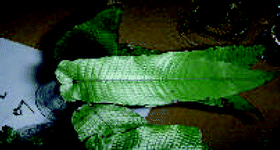Concentrations of rare earth elements (REEs) were determined in the laminae of 10 species of ferns and their acetone-extractable pigments, as well as their host soil and soil extract, by ICP-MS. A new REE hyperaccumulator, Pronephrium simplex, was discovered which could accumulate REEs up to 1.2 mg g−1 dry mass under natural growth conditions. Three typical species of ferns chosen were divided into lamina, petiole, stem and root for the study of REE translocation and fractionation. A hyphenated technique, size exclusion HPLC coupled with online UV/ICP-MS, was developed to provide reliable evidence of the existence of REE-binding proteins in the fern’s lamina. A new REE-binding protein was discovered and separated from the lamina of natural grown P. simplex. Further characterization of the protein showed that its molecular mass is 5068.4 Da by MALDI-TOF-MS and ESI-MS. Amino acid composition analysis by RP-HPLC indicated that the protein has relatively high contents of proline and glycin.

You have access to this article
 Please wait while we load your content...
Something went wrong. Try again?
Please wait while we load your content...
Something went wrong. Try again?


 Please wait while we load your content...
Please wait while we load your content...